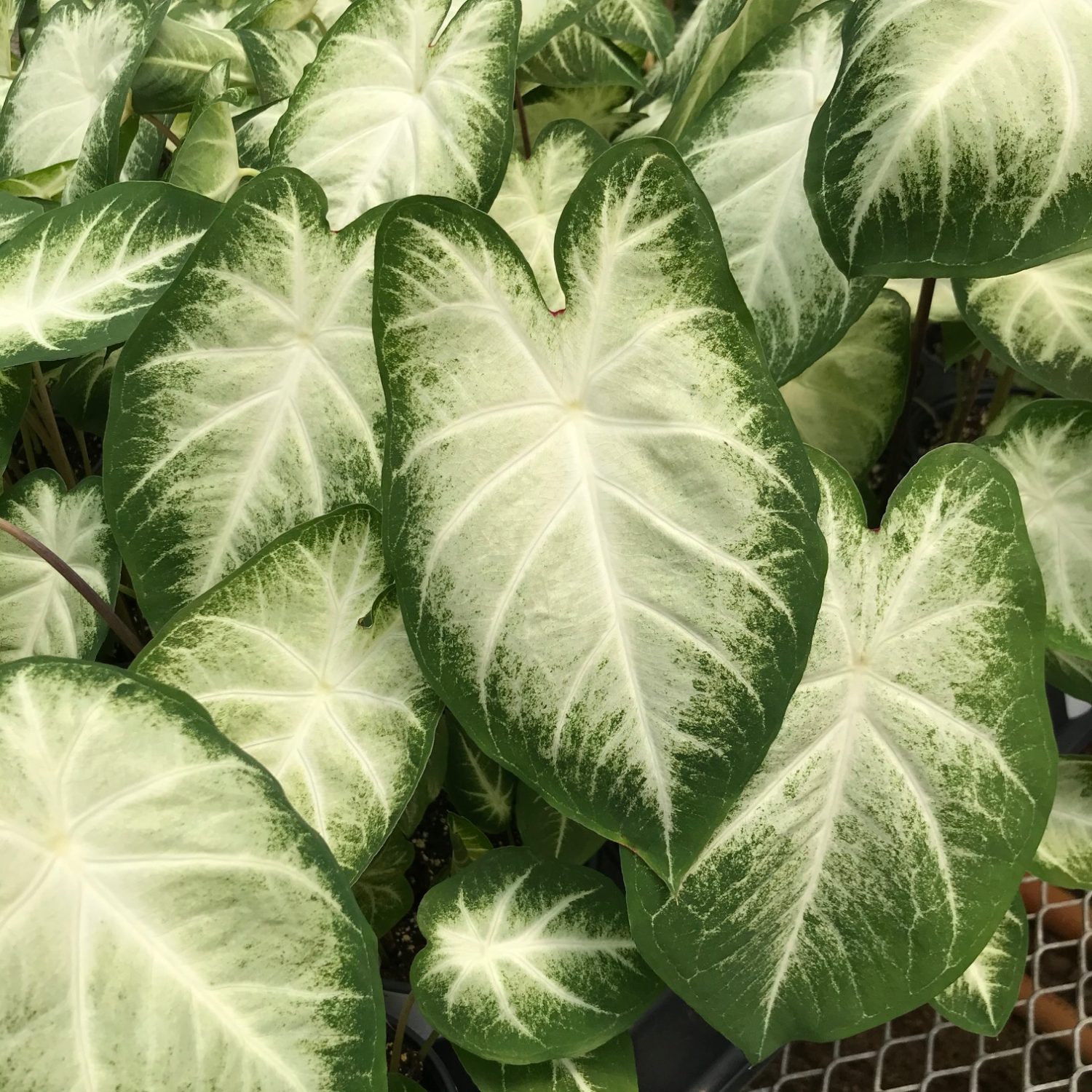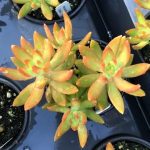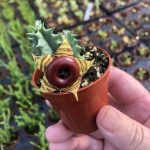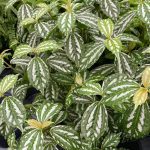Caladium, Aaron
Price range: $8.99 through $12.99
Plant, Zone 9+
Discount per quantity
| Quantity | 3 - 8 | 9 - 14 | 15+ |
|---|---|---|---|
| Price | Price range: $8.72 through $12.60 | Price range: $8.45 through $12.21 | Price range: $8.09 through $11.69 |
| % Discount | 3% | 6% | 10% |
Description
Caladium ‘Aaron’: A Friendly Guide to Growing a White-Green Wonder
Welcome
Sometimes a single plant can light up a shady corner and make us grin. Caladium ‘Aaron’ does that and more. Its broad, heart-shaped leaves glow white in the middle and wear a neat green border like a picture frame. The look is cool, calm, and full of life. In this guide we explore what makes ‘Aaron’ special and how you and your garden can keep him happy year after year.
1. Meet ‘Aaron’
1.1 A Quick Snapshot
- Type: Tropical tuber (fancy-leaf caladium)
- Leaf color: Snow-white center with fresh green margins
- Height & spread: 12–18 inches tall, 12–16 inches wide
- Best spots: Bright shade to dappled sun, warm and humid air
- Family: Araceae, the same family as Elephant Ear and Peace Lily
1.2 A Leaf That Glows
At dawn or dusk the broad white panels almost shine. They pull gentle light into dark areas under trees or porch overhangs. The green edging gives crisp definition so each leaf stands out against the mulch. When a breeze stirs, the cluster ripples like silk.
1.3 Story Behind the Name
Growers wanted a classic white caladium that bounced back fast after shipping and handled summer heat. ‘Aaron’ checked all boxes. It is now a staple in shade gardens across the southern United States and a favorite container thriller farther north.
2. Why We Love ‘Aaron’
2.1 Dazzling Contrast
White foliage pops against ferns, hostas, and coleus. Even plain green impatiens look brighter when ‘Aaron’ plays backup.
2.2 Easy-Going Nature
Given loose soil, warmth, and steady water, ‘Aaron’ grows without fuss. The plant forgives a missed drink and rebounds after short dry spells.
2.3 Long Season of Color
Unlike annual flowers that tire in midsummer, caladium leaves stay lovely from late spring until fall frost. No deadheading needed.
2.4 Small Space Hero
With a tidy height, ‘Aaron’ slips into window boxes, mixed pots, or narrow shade beds where bigger foliage giants will not fit.
2.5 Indoor Flair
In cold zones you can lift the tubers or even pot the plant and bring it indoors. A bright east window turns into a tropical scene.
3. Choosing the Right Spot
3.1 Light Levels
- Ideal: Morning sun, afternoon shade
- Okay: Bright, even shade under high trees
- Edge of Comfort: 3–4 hours of gentle sun in cooler regions
Too much midday sun burns the white parts. The leaf edges crisp and brown. If that happens, add a sheer shade cloth or move the pot.
3.2 Soil Basics
‘Aaron’ likes airy soil rich in humus. Aim for a mixture that drains fast yet holds moisture—think “crumbled chocolate cake.” In beds, blend two shovels of compost into each planting hole. For containers, use a peat-based potting mix with perlite.
3.3 Temperature & Humidity
Caladium tubers wake up when the soil reaches 70 °F. Warm nights above 65 °F make leaves open wider and faster. Humid air keeps edges smooth. In drier climates, mist lightly or cluster plants close so they share moisture.
4. Planting ‘Aaron’ Tubers
4.1 Timing
Outdoors, wait until the last chill passes and the soil warms. In the South that is April to May. In the North it can be late May or early June. Indoors, start six weeks earlier to gain a head start.
4.2 Step-by-Step
- Inspect the tuber. Look for a top side with small eye bumps.
- Set depth. Plant 2 inches deep, eyes up. Too deep slows growth.
- Space right. Keep 8–10 inches between tubers so leaves can fan out.
- Water well. Soak the soil to settle it and erase air pockets.
- Mulch lightly. A 1-inch layer of pine bark keeps moisture even.
4.3 First Shoots
Shoots appear in two to four weeks. If none pop up, gently dig and check. Cold soil or soggy pockets can stall sprouts. Move the tuber to a warmer, drier place and try again.
5. Routine Care
5.1 Watering
Caladiums drink often but hate “wet feet.” Let the top inch of soil dry, then water until you see moisture at the drainage hole. In midsummer heat, containers may need a drink every morning.
5.2 Feeding
These foliage factories love food. Sprinkle a slow-release 8-8-8 or 10-10-10 every six weeks. For a greener punch, add a half-strength liquid fertilizer every two weeks.
5.3 Grooming
Snip off faded or torn leaves at the base. New leaves replace them quickly. Remove lost flower buds—they sap energy but add no beauty.
5.4 Pest Patrol
- Spider mites leave pale speckles; rinse leaves and use insecticidal soap.
- Slugs chew holes in damp beds; sprinkle iron phosphate bait.
- Mealybugs cluster in leaf axils; dab with cotton swab dipped in alcohol.
6. Sunshine in a Pot: Container Tips
6.1 Pot Size
A 10-inch pot suits one tuber. For a showpiece, combine three tubers in a 14-inch pot.
6.2 Mix It Up
Pair ‘Aaron’ with trailing golden lysimachia, pink begonias, or purple oxalis. The white leaves break color clashes and tie the group together.
6.3 Moving Day
During a heat wave, slide the pot to safer shade. When storms threaten, tuck it under cover. Mobility is freedom.
7. Companion Planting in Beds
- Understory team: Ferns, liriope, heuchera
- Color echo: White impatiens, variegated ginger, ‘White Nancy’ lamium
- Texture contrast: Bold hostas, fine Japanese forest grass
Plant taller companions to the north side so ‘Aaron’ still feels the morning sun.
8. Overwintering ‘Aaron’
8.1 Lifting Tubers
In zones below 9, frost will kill the tops. Before that happens:
- Stop watering to let soil dry.
- Cut leaves, leaving a 1-inch stump.
- Lift tubers with a trowel, shake off dirt.
- Dry in a warm room for one week.
- Store in dry peat or sawdust at 60-70 °F.
8.2 Pot Indoors
For a living houseplant, pot the tuber before cold hits. Place near a bright window. Growth slows in winter. Water less but never let soil turn bone dry.
9. Propagation Fun
Caladiums spread by tuber division. In spring, cut a large tuber into chunks with at least one eye each. Dust cuts with cinnamon or fungicide. Plant as usual. Patience rewards with more clumps for free.
10. Troubleshooting Cheat Sheet
| Symptom | Likely Cause | Quick Fix |
|---|---|---|
| Bleached patches | Too much sun | Shift to shade or add cloth |
| Brown edges | Low humidity or fertilizer burn | Mist leaves; flush soil |
| Yellow leaves | Over-watering | Let soil dry slightly |
| No sprouts | Cold or rotted tuber | Warm location; discard mushy parts |
11. Design Ideas
11.1 Moonlit Walkway
Line a shady path with ‘Aaron’ on both sides. At night garden lights make leaves glow like lanterns.
11.2 Porch Planter Trio
Set a tall fern in back, ‘Aaron’ in middle, and cascading white bacopa in front. Guests feel welcome right away.
11.3 Wedding Garden
Mix ‘Aaron’ with blush roses and baby’s breath. The soft palette turns photos dreamy.
12. Stretching the Season
After more than four months of glory, caladium foliage begins to rest. Here are ways to stretch color:
- Feed lightly in late summer to fuel final flush.
- Remove tired leaves to encourage fresh ones.
- In warm zones, leave tubers in ground; they re-sprout next spring.
- In cooler zones, swap pots with fall mums or ornamental cabbage once ‘Aaron’ fades.
13. Kid-Friendly Science
Invite children to touch the smooth leaf surface. Show how water beads and rolls off. Describe how the white areas have fewer chloroplasts yet still gather light. Let them measure daily growth. Simple moments sow lifelong love of plants.
14. Common Questions
Q: Can I grow ‘Aaron’ in full sun?
Only in cool, moist climates and with steady water. Midday sun in hot areas scorches leaves.
Q: Is it toxic to pets?
Yes. Like many aroids, caladium contains calcium oxalate. Keep out of reach of cats, dogs, and curious toddlers.
Q: Why are my leaves small?
Likely cool soil or lack of food. Warm things up and feed balanced fertilizer.
Q: Do I need to deadhead?
No. Flowers are tiny and often hidden. Snip them if they bother you.
15. Our Journey with ‘Aaron’ Continues
We have walked through every stage, from sleepy tuber to shining foliage star. Now it is your turn. Tuck ‘Aaron’ into that dim corner, newborn container, or children’s science plot. Water, wait, and watch the white hearts appear. Together we turn shade into a canvas of calm light—one glowing leaf at a time.
Additional information
| Weight | N/A |
|---|---|
| Options | Bulb – 3 count, 5.5in.(1.25qt) Pot |





